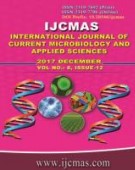


 National Academy of Agricultural Sciences (NAAS)
National Academy of Agricultural Sciences (NAAS)

|
PRINT ISSN : 2319-7692
Online ISSN : 2319-7706 Issues : 12 per year Publisher : Excellent Publishers Email : editorijcmas@gmail.com / submit@ijcmas.com Editor-in-chief: Dr.M.Prakash Index Copernicus ICV 2018: 95.39 NAAS RATING 2020: 5.38 |
The study on “The CENTURY model as a tool to study soil carbon dynamics of coconut ecosystem in the western zone of Tamil Nadu” was carried out in the Agro Climate Research Centre (ACRC), TNAU, Coimbatore during 2016-2017. The objective of the study is to evaluate the suitability of CENTURY model to analyse the soil organic carbon dynamics of coconut plantation in the western zone of Tamil Nadu. The Coconut Research Station (CRS), Aliyar, Pollachi, in Coimbatore district was selected as the study area under western zone of Tamil Nadu. The weather and soil data were collected from the Agromet observatory at CRS, Aliyar, Pollachi. The dynamics of the different carbon pools in coconut ecosystem at CRS was studied from 1850 to 2051 using CENTURY model. As per the simulated data, a steep declining trend was observed from 1850 (7034 g C m-2) to 1860 (3874 g C m-2) in the coconut ecosystem during the initial period and followed a constant decreasing trend up to 1991. Similarly a steep declining trend was noticed in slow carbon pool from 1850 (5076 g C m-2) to 1860 (2056 g C m-2) in the coconut ecosystem in the initial period and followed a constant decreasing trend up to 1991. This may be due to the land use change in the form of conversion from forest to agriculture is usually associated with loss of soil organic carbon. There was a slight increase of total soil organic carbon during 1992 (3178 g C m-2) which was followed by a declining trend up to 2004 (2490 g C m-2). There was also a slight increase of slow carbon pool in 1992 (1720 g C m-2) which was followed by a declining trend up to 2004 (1106 g C m-2). This may be due to high rainfall received in 1992, 1992 and 1994 which was followed by a continuous decrease in rainfall from 1997, 1998, 1999, 2000 and 2001which may be the reason for declining trend in total soil organic carbon as well as slow carbon pool in the coconut ecosystem at CRS, Aliyar, Pollachi. Finally the total organic carbon followed a constant increasing trend from 2004 (2490 g C m-2) to 2051 (2592 g C m-2) and slow carbon pool followed almost a constant increasing trend from 2004 (1106 g C m-2) to 2051 (1307 g C m-2). Active carbon pool has followed a constant decreasing trend from 1850 (289 g C m-2) to 2051(36 g C m-2). Passive pool of carbon has also followed a constant decreasing trend from 1850 (1667 g C m-2) to 2051(1135 g C m-2). Like tree plantations, coconut plantations will be efficient for combating climate change as they help in carbon dioxide sequestration in the short term and mitigating atmosphere levels of carbon dioxide in the long term.
 |
 |
 |
 |
 |